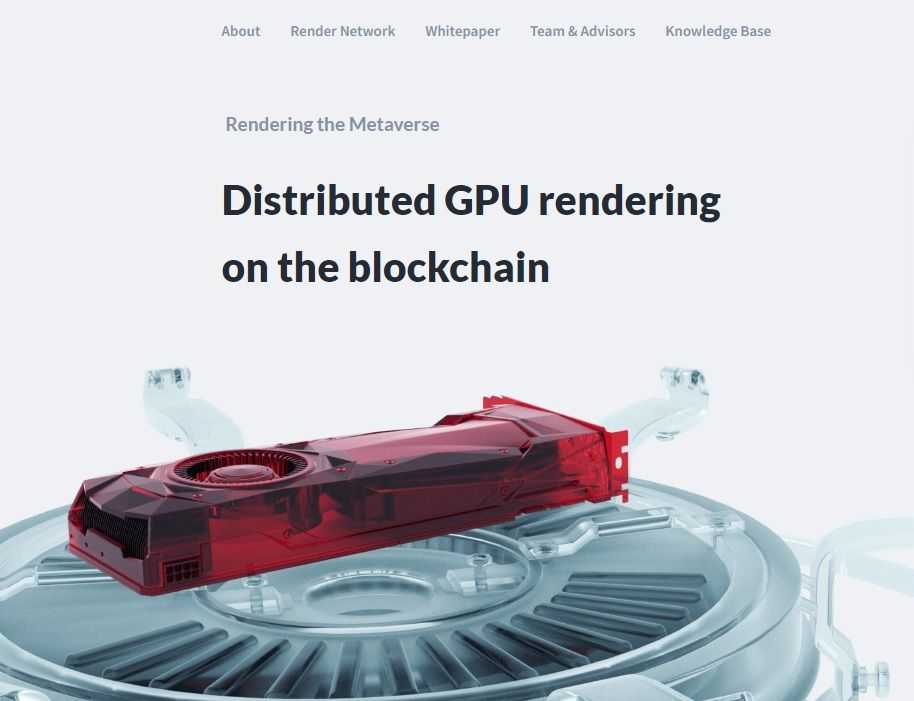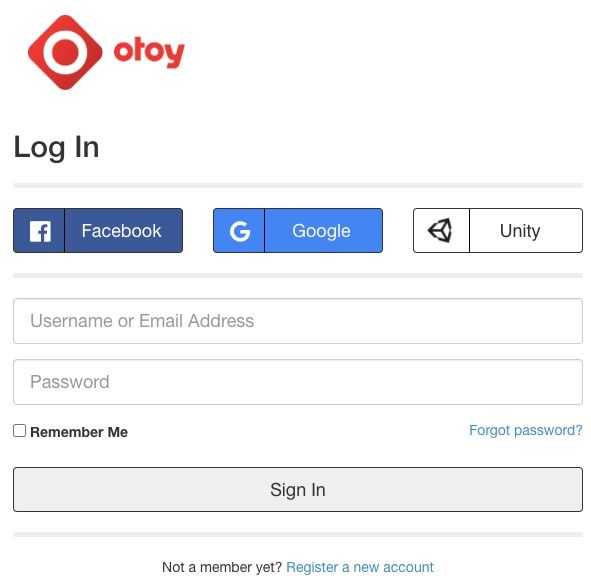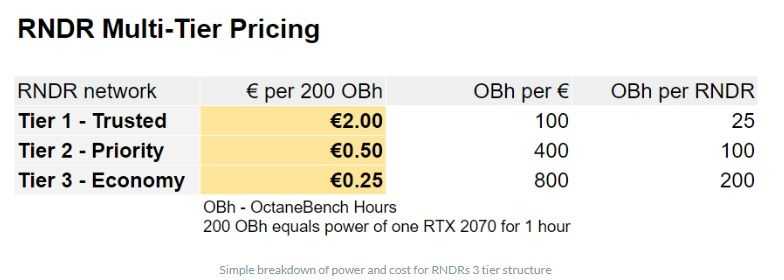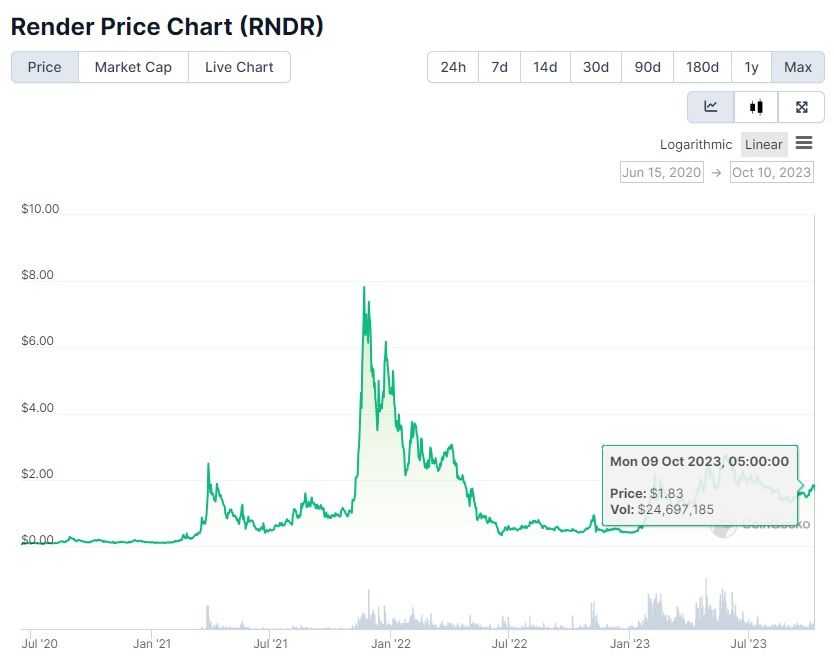Render Network Review: Next-Level Decentralized Computing
I own a PlayStation VR 2 headset. As I slip into the virtual realm, I'm transported to fantastical worlds where I embark on thrilling adventures, slaying robots and battling formidable foes. The adrenaline rush that comes with each encounter, the sharp focus required to solve intricate puzzles, and the immersive feeling of paddling down virtual rivers while kayaking, are thrilling.
But behind my experiences of exhilaration and delight lie certain challenges faced by the thousands of people creating these virtual worlds. The demand for more intricate visuals in animations and VR experiences necessitates external servers and additional resources, leading to increased rendering complexity. Despite this demand, the centralized GPU cloud faces limitations due to high upfront investments and rapid hardware depreciation, resulting in high costs and limited availability.
This puts independent creators in a conundrum — shell out for expensive GPU cloud rendering services or set up their own GPU server infrastructure, which incurs a heavy cost as well. Enter Render Network!
This Render Network review will give you the lowdown on everything you need to know, exploring its features, benefits, use cases and potential risks.
Render Network Review Summary
The Render Network provides decentralized GPU computing power for tasks ranging from basic rendering to machine learning training to complex calculations and Artificial Intelligence, which are in a blockchain-based peer-to-peer network.
| Headquarters | California |
| Year Founded | 2017 |
| Founder | Jules Urbach |
| Native Token | RNDR |
| Total Funding | $30 million |
What is Render Network?
Render Network lets people monetize their otherwise dormant GPU resources by performing renders in return for its native RNDR token. The platform allocates idle GPU power from across the globe for 3D rendering tasks, creating a scalable peer-to-peer GPU cloud computing network. Through this process, Render Network not only minimizes GPU wastage but also offers creators cost-effective, on-demand rendering abilities.

The underlying technology of Render Network is rooted in blockchain technology. It not only stores, validates, and time-stamps intricate technical specifications, schedules, accounts, regulations, protocols, standards, and property rights, but also manages digital rights crucial for assets that are otherwise prone to routine copying.
The integration of the Ethereum blockchain enables the seamless execution of more complex transactions using smart contracts, providing a robust framework for transactions backed by ORBX packages. ORBX is an open-source file format designed to encode all elements of 3D scenes and transfer them between platforms.
As node operators successfully complete scenes on the network, their reputation score increases. Render Network refers to this process as Proof-of-Render where trustworthiness is built on rendering 3D scenes rather than the proof-of-work mining used by other blockchain protocols such as Bitcoin.
The company focuses on virtual reality, mixed reality and augmented reality experiences.
Recently, OTOY (the parent company of Render) was featured in an article by the Harvard Business Review, which explored how Web3 could change the business model of creative work.
Render Network has implemented a MATIC (Polygon) proof-of-stake cross-chain bridge in order to alleviate the long transaction times and high gas prices. The cross-chain bridge allows for easy asset movement between ETH and Matic, where an RNDR and escrow contract has been set up on the Layer 2 system.
Who Founded Render Network?
Jules Urbach is the founder of Render and OTOY. He sets the strategic vision for OTOY and is the chief architect of the company’s technology roadmap.
He made his first game at the age of 18 and went on to make the web's first 3D video game platform and licensed the software to a number of major companies including Disney, Warner Brothers, Nickelodeon and Microsoft.
In addition, Ari Emanuel, the CEO of sports and entertainment company Endeavor, and movie director JJ Abrams are advisers to the company.
What's the Role of the Render Network Foundation?
As the Render Network has evolved into one of the largest decentralized GPU computing and GPU cloud rendering networks in the world, it has introduced a decentralized governance framework, led by the Render Network Foundation.
The foundation considers it important that active and engaged network participants are rewarded with ownership of the network in order to ensure that the network continues to evolve in the direction that serves its users most effectively.

Every member of the Render Network community is considered a part of the foundation, as long as they are active participants.
How to Join Render Network?
If you're looking to join Render Network, there are two ways you can go about it. You can either join as a node operator (lend GPU power) or as a creator. Let's explore the two!
Node Operators
Perhaps you bought the shiny new GPU to play games, but haven't been able to find any free time. If you have unused GPU power, you could rent it out via Render Network and earn some RNDR tokens for time spent rendering.
Once a creator confirms that the renders were successfully processed, you will receive your RNDR tokens. Payouts are made every 7 to 10 days in a consolidated transaction to save on transaction fees required to make payments on the Ethereum blockchain.
The network scores users based on their success rate and past performance. If node operators do not successfully process work, their reputation will take a hit. Node operators with higher reputation scores are assigned work faster than those with low scores, incentivizing them to maintain high success rates.
Render Network says you should only connect your node to the network when you are able to commit most of your GPU, RAM and CPU resources. If you have a lot of GPU-intensive background tasks running while processing renders on the Render Network, it may lead to job failures that will hurt your reputation score and may lead to a potential quarantining of your node.
Creators
If you're someone who makes digital visuals, you're a consumer or a "creator" in Render Network parlance.
Just like node operators, creators have to be cognizant of their reputation score as well. If creators reject work that is properly rendered, their reputation score is reduced. For creators, reputation scores are used to determine the amount of concurrent mining nodes a user can access at any given time. As a result, creators with higher reputation scores are able to process work faster.
If you have insufficient funds to process a job, you will have to add tokens to your account in order to submit the job. Also, if you run out of RNDR tokens in your account while your rendering is in progress, your job will be paused until more tokens are added to your account. There are two ways of adding funds:
- RNDR Token: RNDR is Render Network's native token. These can be purchased and sold on exchanges.
- RNDR Credits: Unlike the token, RNDR credits can be purchased using PayPal and Stripe, directly through the Render Network portal on rndr.x.io. When a user purchases RNDR credits, they are backed by RNDR tokens that have been purchased off of an exchange by Render Network. This means that when a creator pays for a job using RNDR credits, node operators are paid out in RNDR tokens for their work.
How to Get Started as a Node Operator
To become a node operator, there are certain hardware requirements you must meet:
- A CUDA-enabled NVIDIA GPU and a minimum of CUDA 10.1 drivers with support for compute capability 3.0 or higher (the minimum driver version is 419). Render recommends at least 6GB of VRAM, and over 8GB VRAM.
- RAM helps your node process more complex scenes, which means the higher your RAM, the more computing power your node can take on. Render recommends more than 32GB RAM.
- Strong network connectivity is required to download and upload assets.
- 100 GB of free disk space is recommended.
Connecting your Node to the Render Network
To join the network as a node operator, you must first complete a form, and you will be added to the onboarding queue.
Once your node is ready to start mining, the Render Network team will detail everything in an email, but here's a top-level view:
- Download and install the application sent to you by the Render Network team. Information for setting up your node will be included in the email.
- Once you're all set, open and run the Render Network client. At this point, you will have to add your Ethereum wallet. It's important that you link the same wallet you shared previously with the Render Network team. Once you copy your ETH Wallet ID, click "Set wallet ID." If you do not see this popup in your taskbar, check your security and firewall settings.
How to Get Started as a Creator
To get started on the creator portal, you must have an active OctaneRender license or a subscription, which is currently €23.95 per month (billed annually) or €239.88 annually, which comes out to €19.99 per month. If you own a subscription or have a license, you can start rendering at rndr.x.io, where you log in with your OTOY account.

This is what a creator's journey looks like on Render Network:
- Checking Octane Version: The Render Network supports the most stable versions of OctaneRender.
- Exporting to ORBX file format: To upload a scene to the Render Network, the scene needs to be exported as an ORBX file, using OctaneRender Standalone or any of the supported OctaneRender plugin integrations. Checking a scene and optimizing it in Octane Standalone before it is uploaded to the Render Network is recommended to avoid errors, re-renders or unnecessary costs.
- Create Job Parameters for Rendering: When you have a scene to render, you can create a job. To begin this process click the “Create a Job” button on your scene. You will be redirected to the “Create a Job” page, where you will have several options.
- Estimate Job Costs: The final step before rendering is generating a cost estimate. This is to avoid the final job cost exceeding the number of tokens that were temporarily held for rendering. If the amount of work exceeds the number of tokens/credits in your account, the render will be paused and you will be prompted to add more tokens/credits to your account to resume the render.
How Much Does RNDR Cost?
Render Network has a multi-tier pricing structure, based around speed, security and cost.
Both the RNDR token and credit are mapped to a unit of work called OctaneBench, a tool created by OTOY to define the computing power provided by any combination of graphics cards into a single score. When setting up a job, creators select a tier based on their preferences for speed, cost, security and node reputation.
Render Network currently has two pricing tiers:
- Tier 1 (Priority): This provides rendering queue priority, more power and faster average speeds to handle larger and more complex scenes.
- Tier 2 (Economy): Provides the most economic rendering solution. Queue priority and requisite node power are not guaranteed. This tier is recommended for work that is not time-sensitive.

The company is also currently working on another tier called "Trusted." Once that's rolled out, that'll become Tier 1.
Multi-tier pricing operates using a multiplier attached to the OctaneBench algorithm.
- Tier 1 (Trusted) work has an OctaneBench multiplier of 1x.
- Tier 2 (Priority) has a multiplier that varies between 2x and 4x (thus, an artist will receive 2x to 4x more OB work at Tier 2 when compared to Tier 1).
- Tier 3 (Economy) has a multiplier of 8x to 16x when compared to Tier 1.
RNDR Token
RNDR is an ERC-20 utility token designed to power rendering work on the Render Network. RNDR tokens can be purchased and sold on exchanges and can be earned by node operators for work rendered on their nodes.
This is what the RNDR token allocation looks like:
- 25% has been sold
- 10% is in the RNDR reserve
- 65% is in escrow for supply/demand flowback to the network
As the network scales, Render says it will need to flow more tokens into the ecosystem. These tokens will either come through the reserve as user acquisitions, bonuses for node operators, airdrops, or other future token allocation methods. In the meantime, these tokens are sitting in a third-party custody and escrow account.
Render Network has undertaken two token sales:
- A public sale in October 2017 where 1 RNDR token was equivalent to $0.25.
- A private sale from January to May 2018 where 1 RNDR token equalled $0.25.
The token's price has come a long way since.

Today, the token is the 57th largest by market capitalization, and its current price represents a decline of over 80% from its all-time high of $8.78 in November 2021. The RNDER Token has been one of the better performers in the 22/23 bear market and has even seen positive price action in recent months as excitement grows around the project.
Where can you buy RNDR Tokens?
If you're looking to purchase RNDR, you can check out crypto exchanges such as Gate.io, Binance, Bitget, Coinbase and Kraken.
If you're in the market for a reliable exchange, head over to our article that examines the best crypto exchanges.
What are the Benefits of Render Network?
Render Network has a lot going for it:
- Scalability: Embracing a decentralized global network for next-generation 3D rendering provides stability by efficiently managing computational scale, preventing overloads, enhancing resilience against failures, and offering seamless scalability.
- Efficiency: Render Network's efficiency stems from its ability to transform idle GPUs into valuable assets, creating an ecosystem where supply meets demand in real-time. Through global coordination, decentralized scalability, transparent transactions, and cost-effectiveness, the network ensures that artists and developers can access the computational power they need efficiently and affordably.
- Digital Rights Management: Next-generation immersive media and artificial intelligence require new forms of authentication and provenance. The Render Network provides granular digital rights management through on-chain traceability of a node-based render graph.
Render Network's approach paves the way for a more inclusive, diverse, and collaborative community of creators and innovators in several ways:
- Accessibility and Affordability: Render Network reduces rendering costs and time up to 90% compared to traditional cloud services. This ensures that computational power is accessible to budget-savvy creators, unlocking the potential for the next generation of 3D content and Artificial Intelligence creation.
- Inclusivity through Global Coordination: Render Network's global coordination and decentralized scalability ensure that computational resources are distributed worldwide. This inclusivity breaks down geographical barriers, enabling creators from different countries and regions to collaborate seamlessly.
- Transparent and Fair Ecosystem: The transparent transactions facilitated by Render Network instil trust within the community. Creators can be assured of fair compensation for their work through the platform's on-chain traceability.
- Empowering Independent Creators: Render Network's cost-effectiveness and accessibility empower independent creators, enabling them to explore their creative potential without financial constraints.
- Supporting Collaboration and Innovation: Render Network's real-time supply and demand matching, along with seamless scalability, facilitates collaborative projects as creators and innovators can easily find the computational resources they need.
- Protection of Creative Assets: The granular digital rights management provided by Render Network ensures that creators maintain control over their intellectual property. This protection encourages creators to share their work without fear of plagiarism or unauthorized use.
Render Network Use Cases
The Render Network is a versatile platform catering to an audience encompassing artists, engineers, designers and developers. It opens doors to an array of GPU workloads and applications.
Visual Effects and Motion Graphics
Independent artists and studios, leveraging the Render Network, can delve into the realm of large-scale 3D visual effects, a feat that would typically demand substantial upfront investments. The platform offers artists the flexibility of nearly limitless on-demand GPU resources, allowing them to render scenes at higher resolutions or multiple output formats.
Virtual Assets and Non-Fungible Tokens (NFTs):
The Render Network empowers 3D artists to craft non-fungible tokens and virtual assets, ensuring comprehensive provenance tracking. Moreover, artists can venture into the creation and tokenization of next-generation virtual assets, including interactive ORBX files. This functionality facilitates the monetization of portable 3D virtual assets, enhancing the creative and financial opportunities for artists in the digital space.
Virtual Production
For directors and cinematographers, the Render Network is a transformative tool. It enables the seamless integration of live action with vast, rendered 3D environments, revolutionizing the filmmaking process. This integration empowers creators to explore unlimited takes and push the boundaries of virtually crafted cinematic worlds.
What are the Challenges of Render Network?
Render Network isn't all shiny and chrome. Just like every other business, it too faces its own set of unique challenges.
Combining Blockchain and AI
While the two technologies hold immense promise, they also present challenges:
- Data Privacy: Blockchain networks are inherently transparent, which can conflict with the privacy requirements of certain AI applications. Ensuring that sensitive data used by AI algorithms remains private and secure while being processed within a transparent and immutable blockchain is a complex problem.
- Interoperability: Integrating diverse AI algorithms and blockchain platforms can be challenging due to the lack of standardized protocols. Ensuring seamless communication and data exchange between different AI models and various blockchain networks is a technical hurdle.
- Security Risks: Blockchain networks are touted for their security, but they are not immune to attacks. Smart contracts, which are integral to Render Network, can contain vulnerabilities that AI-driven attacks might exploit. Ensuring the security of both the blockchain infrastructure and the AI algorithms is paramount.
Regulatory Risks
Operating in a decentralized environment, especially within the world of emerging technologies like blockchain and cryptocurrencies, brings with it regulatory uncertainty and legal risks.
Many governments and regulatory bodies, especially the U.S., have yet to establish comprehensive guidelines and laws specific to decentralized platforms. This lack of clear regulations creates uncertainty, making it challenging for businesses and individuals to understand legal obligations and potential liabilities.
Render Network transcends traditional geographical boundaries. This makes determining which jurisdiction's laws apply in the case of disputes or legal matters becomes complex. Different countries have varying regulations regarding blockchain, cryptocurrencies, and decentralized applications, which may lead to conflicts in legal interpretation and enforcement.
AML and KYC regulations are stringent in the financial sector to prevent money laundering and illicit activities. Ensuring compliance with these regulations in decentralized environments, where transactions are pseudonymous, poses significant challenges.
Competitors
Golem Network is another company that works more or less like Render Network.
Golem is a global, open-source, decentralized supercomputer that anyone can use. It is made up of the combined computing power of users' machines, from PCs to entire data centres. To facilitate that exchange, Golem implements a decentralized marketplace where IT resources are rented out. The participants in this decentralized network can assume one of the following two roles:
- Requestor: This is someone with a need to use IT resources such as computation hardware.
- Provider: Someone who has free IT resources that can be shared with others in the network.
The main difference between Golem and Render is that the former focuses on a wide range of use cases such as CGI rendering, scientific calculations, and machine learning, and while Render does all that too, its main focus is on AR, VR and MR.
What is the Future of Render Network?
Right now, bolstering the Render Network's capacity, finishing the Render Network SDK, providing Arnold support (via Hydra in the Render Network SDK), and validating some non-RNDR apps are the company's main priorities. Once these are done, the company has some interesting ideas:
- SiaCoin: This is a project the Render Network team has kept on its radar for a number of years, and the possibility of integration has been discussed.
- Basic Attention Token: BAT's technology for mapping ads and ad viewership has been discussed as a framework for potential Render Network development in ray-casting ad topology across virtual 3D spaces.
- Decentraland: The metaverse gaming app is on the company's radar as well.
Render Network: Closing Thoughts
Render Network solves the challenges faced by creators in the virtual realm. By offering decentralized GPU computing power through blockchain technology, Render Network revolutionizes 3D rendering and computational tasks. The platform minimizes GPU wastage while providing on-demand rendering solutions in a cost-effective manner.
For Render Network, scalability, efficiency, and commitment to digital rights management is the name of the game. Its transparent, fair ecosystem empowers independent creators, fosters collaboration and innovation, and supports the protection of creative assets.
However, Render Network is not without its challenges. The integration of blockchain and AI presents complex issues related to data privacy, interoperability, and security. Moreover, operating in a decentralized environment brings regulatory risks and uncertainties, which can prove to be bumps in the road.
Render Network's journey signifies a significant step towards democratizing computational power, empowering creators, and shaping the future of immersive digital experiences.
Frequently Asked Questions
Render Network provides a decentralized GPU computing platform that connects creators in need of computational power for tasks like 3D rendering with individuals who have idle GPU resources. It allows users to monetize their dormant GPU resources and perform rendering tasks in exchange for its native token, RNDR.
RNDR operates on the Ethereum blockchain but uses a Polygon bridge to alleviate the long transaction times and high gas prices.
RNDR tokens are used within the Render Network platform to pay for rendering tasks and computational services. Creators and developers can use RNDR tokens to access on-demand GPU resources, perform 3D rendering, and execute other GPU-intensive tasks. Node operators, individuals who lend their GPU power to the network, earn RNDR tokens as compensation for processing rendering jobs. RNDR tokens can also be traded on cryptocurrency exchanges, providing liquidity to users who wish to convert them to other cryptocurrencies or fiat currencies.
Rendering is the process of generating images or videos from 3D models or scenes. In the context of computer graphics, rendering transforms a digital description of a 3D object or environment into a 2D image or animation.
ORBX is an open-source file format designed to encode all elements of 3D scenes and transfer them between platforms. It is developed by OTOY, the parent company of Render Network. ORBX files encapsulate 3D models, textures, animations, shaders, and other scene data into a single, compact file format. This format ensures that the entire 3D scene, including its complexity and visual details, can be easily shared and rendered consistently across different software applications and platforms. ORBX files are used in the context of 3D rendering, virtual reality, and computer graphics to maintain the integrity and portability of 3D content.
Disclaimer: These are the writer’s opinions and should not be considered investment advice. Readers should do their own research.


